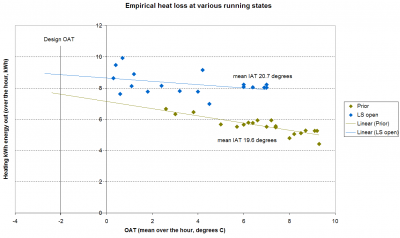Posted by: @cathoderayThey give different heat losses at design OAT (-2 degrees), ~7.5 and ~8.8 kWh, but that is because the mean IAT was different. Any empirical heat loss should always state the mean IAT to which it applies.
Loss is of course dependent on IAT (as we know its proportional to IAT-OAT).
If by empirical loss determination you mean loss determination using gas/oil consumption, then the (implicit) assumption is that the house is heated to the IAT desired by the occupants, so the calculated loss is at that temperature. If this figure is used to design the system to work at another IAT then an adjustment is in principle needed of course. Likewise if the house is heated part time an adjustment is needed.
The upshot of this is that some care is needed in interpreting empirical results, just as some care is needed in using the GIGO spreadsheet. Thats one reason I see the two as complementing each other not in competition.
Was that the question you were asking?
4kW peak of solar PV since 2011; EV and a 1930s house which has been partially renovated to improve its efficiency. 7kW Vaillant heat pump.
Posted by: @jamespaWas that the question you were asking?
It wasn't so much a question as an observation: "What I think it means is you have to pay very close attention to the IAT".
Instead of using "the (implicit) assumption...that the house is heated to the IAT desired by the occupants", it is better explicitly to state the actual (mean) IAT when the assessment was done, as a guard against inadvertently determining a heat loss at one (mean) IAT when one is actually more interested in another (mean) IAT.
Midea 14kW (for now...) ASHP heating both building and DHW
Posted by: @cathoderayInstead of using "the (implicit) assumption...that the house is heated to the IAT desired by the occupants", it is better explicitly to state the actual (mean) IAT when the assessment was done, as a guard against inadvertently determining a heat loss at one (mean) IAT when one is actually more interested in another (mean) IAT.
Yes. If one were going to develop this as a published method I think there are several conditions to be applied.
4kW peak of solar PV since 2011; EV and a 1930s house which has been partially renovated to improve its efficiency. 7kW Vaillant heat pump.
@jamespa - I think it also applies to an informal DIY assessment, that's why I am stating it here, because it may not be immediately obvious to everyone.
Midea 14kW (for now...) ASHP heating both building and DHW
Posted by: @cathoderay@jamespa - I think it also applies to an informal DIY assessment, that's why I am stating it here, because it may not be immediately obvious to everyone.
Indeed it does. Everything in this business has gotchas somewhere!
4kW peak of solar PV since 2011; EV and a 1930s house which has been partially renovated to improve its efficiency. 7kW Vaillant heat pump.
Heat transfer through objects can be determined by the equation:
Q = U.A.DT
Q = Energy transfered, kJ
U = Heat Transfer Coefficient, kJ/m2/C
A = surface area, m2
DT = temperature difference, C
The equation can be used to calculate the heat transfer through walls if you know a value for U and A.
So, as CathodeRay says, heat loss (Q) does depend on the internal air temperature, since DT = Inside - Outside. (and the number of air changes, how draughty your house is).
Bob
@bobtskutter - you may not have seen them (and why should you!), but we have at various times discussed using empirical methods of determining heat loss, since the calculator/spreadsheet methods often over-estimate the loss (U values to high especially for old stone walls like mine, too many air changes being likely culprits). The basic idea is plot OAT against kWh out at steady IATs and the point where the regression line reaches the design OAT gives you the kWh out at that OAT and as long as your home is in steady state that is your heat loss. The point I was making (to @jamespa, who has been heavily involved in the discussion) was that if you inadvertently (without realising it) do such an analysis in a clamped system (as mine was) you might end up with too low a heat loss, the great secret is to check the IAT is reasonably constant throughout.
I'm letting my system run for a while with lock shields all open, CC1 on the circulating pump and WCC lowered by 2 degrees, and will then plot the data. Still not cold at the moment, OAT 8 degrees, IAT 20.3 degrees.
Midea 14kW (for now...) ASHP heating both building and DHW
@cathoderay Ah OK, sounds like an interesting way to observe heat loss. I didn't mean to step on people's toes. I'm looking forward to seeing more data from your data logger.
Regards
Bob
Posted by: @bobtskutterHeat transfer through objects can be determined by the equation ....
So, as CathodeRay says, heat loss (Q) does depend on the internal air temperature, since DT = Inside - Outside. (and the number of air changes, how draughty your house is).
Bob
Its good to have someone else who comes at this, like me, from a physics perspective. I also noticed you doing energy balances, one of my favourite techniques when trying to understand this stuff.
Im currently trying to persuade ChatGPT to solve the equations for setback, and more to the point recovery. I suspect I could have done so 30 years ago but I'm now a bit rusty. I got much of the way myself a year ago, but lost interest as the summer started. A question from @cathoderay has brought it to the fore again.
If you are any good at (and enjoy) algebra and solving differential equations id be grateful for help, otherwise I will see if I can coach ChatGPT to do the right thing, which in fairness it got close to yesterday but on further inspection it was wrong.
4kW peak of solar PV since 2011; EV and a 1930s house which has been partially renovated to improve its efficiency. 7kW Vaillant heat pump.
Posted by: @bobtskutter@cathoderay Ah OK, sounds like an interesting way to observe heat loss. I didn't mean to step on people's toes. I'm looking forward to seeing more data from your data logger.
Regards
Bob
Not stepping on toes at all. Its an interesting discussion how best to determine heat loss, which is so key to getting a heating system design right. I have a particular interest because I had 2 full 3 hour surveys done (one of which I paid for), both of which came out at 16kW. I asked for the detail of the paid-for one and it turned out they had ignored invisible fabric upgrades (which I had made a point of telling them about) and counted room to room losses but not room to room gains. Correcting for these errors I got to 10.5kW. However the measured loss (based on plotting gas consumption against OAT and other analyses of my gas consumption) was 7kW. The difference between this and 10.5kW can be accounted by assuming ACH=0.5 instead of the MCS defaults for a 1930s house with some modern extensions.
I fitted a Vaillant '7kW' heat pump (actually 8.5kW at the design conditions), its clearly the right size, and along the way a couple of installers have told me that the default ACH values are indeed a gross overestimate in almost all cases.
Im firmly of the opinion that empirical methods should, wherever possible, be used as a minimum to 'sense check' the GIGO spreadsheet (my description). There also seem now to be a minority of installers that are prepared to take such measurements into account. I cant believe Octopus arent doing more sophisticated analyses given that they have access to half hourly readings and now heat pump installations, and also cant help but feel that there is a lot to be learned by an in depth analysis of half hourly meter readings where they are available. Obviously loss does depend on IAT, but I reckon that you could probably work out a lot from consumption and OAT only with some clever algorithms.
4kW peak of solar PV since 2011; EV and a 1930s house which has been partially renovated to improve its efficiency. 7kW Vaillant heat pump.
@JamesPa OK, I'll give it a go (no promises), point me in the direction of what you're trying to solve.
Edit: Just had a thought, one technique I use a lot is to use Excel to model the problem over a small time frame. You can integrate and differentiate with Excel if you use enough rows!! Just break the problem down into 1second time frames and consider each second as a small energy balance.
@cathoderay I'm not entirely sure how you actually could calculate heat lost, at least not with any great certainty. But I guess that's the problem you're trying to solve.
Bob
Posted by: @bobtskutterI'm not entirely sure how you actually could calculate heat lost, at least not with any great certainty. But I guess that's the problem you're trying to solve.
It is the problem we were trying to solve, we being largely but by no means exclusively @jamespa and me. As JP has already mentioned, he has a background in physics, I am a retired doctor. This is actually a useful combination, because although we both have had a scientific training with all that that entails, the emphasis within the science is different. I for example tolerate noisy messy natural experiments (because in epidemiology that is often the best you can hope for), and tend to place far greater faith in empirical results at the expense of whatiffery (my name for modelling in Excel 'what if' spreadsheets). I've see such whatiffery get things very wrong in medical science. When I do an analysis, say a scatter plot and then fit a line to the data, I call that doing a scatter plot with linear regression, not modelling!
The idea behind the empirical heat loss is very simple, when a building is in balance (ie steady IAT), then the energy in must equal the energy out, otherwise the IAT would change*. Since (with a steady IAT) the energy out (heat loss) varies linearly with the OAT, a plot of hourly or daily mean OAT against energy in (which is equal to energy out in steady state IAT) should produce a straight line with a high correlation (which it does), then the heat loss at design OAT can be read by reading the kWh in at the design OAT.
I did all this after my heat pump was fitted, largely to check my installers (or rather Freedom's) spreadsheet based heat loss (12.3kW). My empirical heat loss at design conditions comes out at just under 9kW - but is very IAT dependent (as indeed would be expected) and this is visible in the chart I posted earlier with the 'prior' and LS open lines with regression lines extended to design OAT:
This plot is based on only a small number of readings, more readings tend to produce tighter plots. Nonetheless, as can be seen, the heat loss based on the upper line, which is close to design IAT (20.7 against a design IAT of 21 degrees), comes out at about 8.8kW, whereas the lower line with only a slightly lower IAT (19.6 degrees) suggests a heat loss of around 7.5kW. As I say, this isn't surprising, lower IAT needs less energy, but it does emphasise the need to know what the IAT is during the assessment.
There is no reason why such an approach can't be used before a heat pump is selected and installed, provided sufficiently detailed energy use data is available. Indeed, that is exactly what JP did before fitting his heat pump, and again he found a marked discrepancy between the calculated heat loss and the empirical heat loss. My guess is installers aren't too bothered about this, because it means they will tend to fit over-sized heat pumps, a legacy approach based of fitting fossil fuel boilers that are well over-sized, but less suited to heat pumps.
* Edit: meant to add, 'even if there is some complicated physics behind this, due to thermal mass and the building's fabric becoming a sort of thermal battery that can charge and discharge'.
Midea 14kW (for now...) ASHP heating both building and DHW
- 26 Forums
- 2,342 Topics
- 53 K Posts
- 180 Online
- 6,000 Members
Join Us!
Worth Watching
Latest Posts
-
RE: Who's your electricity provider and what's your tariff?
I've not heard anything about this, as yet. I get the ...
By Sheriff Fatman , 4 hours ago
-
Agree with @majordennisbloodnok on the setbacks. We hav...
By ChandyKris , 6 hours ago
-

RE: Advice on internal circulation pump noise
I agree with @jamespa that your buffer tank and seconda...
By GrahamF , 7 hours ago
-

RE: Heat Pump Heats the House… But It’s Not Cosy. Emitter Changes or System Tweak?
A quick Google search showed that building regulations ...
By GrahamF , 7 hours ago
-
RE: Octopus Cosy Heat Pump Owners & Discussion Thread
@agentgeorge I first heard (read) about it on FB this m...
By AndrewJ , 7 hours ago
-
RE: New Fogstar 15.5kWh upright solution
It is a matter of luck. 2ith Fogstar "instructions", to...
By Batpred , 7 hours ago
-

RE: Speedcomfort radiator fans
@deltona the way the links were added broke the page. A...
By Mars , 8 hours ago
-

RE: Setback savings - fact or fiction?
I agree! Even more so if we get an answer! But the chal...
By cathodeRay , 10 hours ago
-

RE: Refrigerant R32, is it now banned in the EU from 1st Jan 2027 for monobloc ASHPs?
This has been delayed from what I believe to be this ye...
By dgclimatecontrol , 13 hours ago
-
RE: Are We Sleepwalking Into Another Race to the Bottom?
this is why I provided current flow temperatures in the...
By ksim , 14 hours ago
-

RE: Why Millions of UK Homes Struggle With Heat Pumps
There's many homes that would be quite a disruption for...
By dgclimatecontrol , 14 hours ago
-
RE: Ecodan unable to hit legionella target temp - what's the consensus?
@rhh2348 ...maybe this option is what you want? Alter...
By benson , 14 hours ago
-

RE: Free Ecoheat Heat Pump Install
@old_scientist This does make the unit smaller as the b...
By dgclimatecontrol , 14 hours ago
-
RE: Ecodan - Legionella Operation Time and Target Temperature
@old_scientist hiya mate, did you ever get to the botto...
By 9jwr9 , 20 hours ago
-
RE: Configuring third party dongle for Ecodan local control
@majordennisbloodnok I think the HPDHD diagnosis may be...
By Sheriff Fatman , 1 day ago
-

RE: External pipework insulation
I don't think we can tell from a photo whether your exi...
By Transparent , 1 day ago
-
RE: Controlling Daikin Altherma via P1P2 and Home Assistant
@majordennisbloodnok That’s correct. I can’t find anywh...
By weoleyric , 2 days ago
-

RE: A Smarter Smart Controller from Homely?
@papahuhu I hope you get a swift resolution. Regards, T...
By Toodles , 3 days ago






